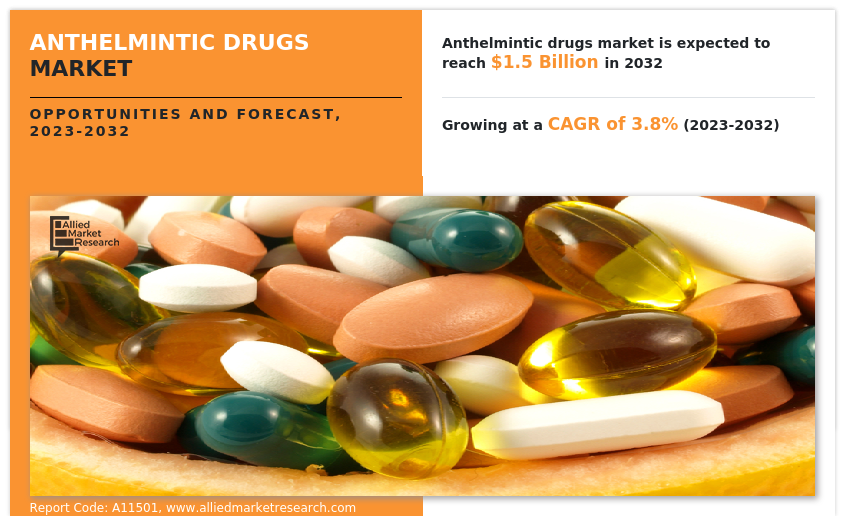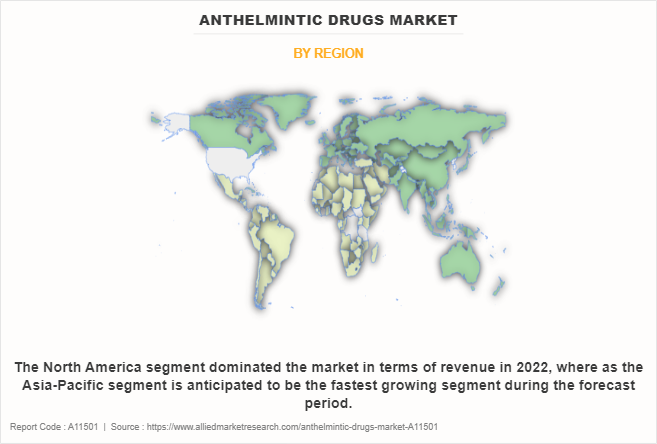
According to a report by Allied Market Research titled “Anthelmintic Drugs Market,” the global market for anthelmintic drugs is categorized by drug class into Benzimidazoles, Macrocyclic Lactones, Pyrazinoisoquinolones, Tetrahydropyrimidines, and Others. Infection types include Cestode Infections, Nematode Infections, Trematode Infections, and Mixed Infections. Distribution channels encompass Hospital Pharmacies, Drug Stores and Retail Pharmacies, and Online Providers. The report indicates that the market was valued at $1.0 billion in 2022 and is expected to reach $1.5 billion by 2032, with a compound annual growth rate (CAGR) of 3.8% from 2023 to 2032.
The global anthelmintic drugs market is experiencing growth, propelled by several factors. Firstly, there has been a rise in incidences of parasitic infections worldwide, emphasizing the need for effective treatment options. Additionally, there is an increased awareness of preventive measures against helminth infections, encouraging individuals to seek out appropriate medications. Moreover, the availability of generic medications has made treatment more accessible to a larger population. These factors combined contribute to the expansion of the global anthelmintic drugs market, addressing the critical issue of parasitic infections on a broader scale.
Request Sample of the Report on Anthelmintic Drugs Market Forecast 2032- https://www.alliedmarketresearch.com/request-sample/11866
Prime determinants of growth
The prime determinants of growth in the anthelmintic drugs market revolve around several key factors. Firstly, there’s a notable rise in incidences of parasitic infections globally, creating a heightened demand for effective treatments. Additionally, there’s an increase in awareness regarding preventive measures against Helminth infections, which empowers individuals to take proactive steps in controlling the spread of these infections. This increased awareness leads to a more proactive approach to managing helminth infections, resulting in a higher number of individuals seeking timely treatment with anthelmintic drugs. Ultimately, this surge in awareness and prevalence contributes significantly to the growth of the anthelmintic drugs market.
Economic Downturn Analysis: Impact of Recession in 2023 on the Anthelmintic Drugs Market
The anthelmintic drugs market, like any other sector of the economy, is indeed susceptible to the effects of recessions. During economic downturns, the market may experience both positive and negative impacts.
On the positive side, there might be an increased focus on public health measures during recessions. Governments and healthcare organizations may allocate more resources towards controlling the spread of infectious diseases, including parasitic infections. This could lead to heightened awareness campaigns, improved healthcare infrastructure, and increased funding for research and development of anthelmintic drugs.
However, recessions can also have negative consequences for the anthelmintic drugs market. Economic downturns often result in reduced consumer spending power, which could lead to decreased demand for healthcare products, including anthelmintic drugs. Additionally, budget cuts in healthcare spending by governments or insurance companies may limit access to these medications for certain populations.
Overall, while recessions can present challenges for the anthelmintic drugs market, proactive measures and strategic planning can help mitigate the negative impacts and capitalize on potential opportunities for growth.
Leading Market Players: –
- GlaxoSmithKline plc
- Johnson & Johnson
- Merck & Co., Inc.
- Bayer AG
- Cipla Ltd.
- Sun Pharmaceutical Industries Ltd.
- Teva Pharmaceutical Industries Limited
- Reese Pharmaceutical Company
- Zydus Lifesciences Limited
Want to Explore More, Connect to our Analyst- https://www.alliedmarketresearch.com/connect-to-analyst/11866
The benzimidazoles segment to maintain its leadership status throughout the forecast period
The benzimidazoles segment is poised to maintain its leadership status throughout the forecast period. In 2022, this segment held the highest market share, accounting for nearly one-third of the global anthelmintic drugs market revenue. The growth of this segment is primarily driven by the increasing number of prescriptions for drugs such as albendazole and mebendazole, which are commonly used for the treatment of parasitic infectious diseases.
Conversely, the macrocyclic lactones segment is projected to be the fastest-growing segment during the forecast period. This growth is primarily attributed to the rising adoption of ivermectin, both in branded and generic forms, for the treatment of parasitic infections. Ivermectin’s efficacy and versatility in treating a wide range of parasitic infections contribute to its growing popularity and subsequent market growth within this segment.
The nematode infections segment to maintain its lead position during the forecast period
The nematode infections segment is expected to maintain its lead position throughout the forecast period. In 2022, this segment accounted for the largest share, comprising more than one-third of the global anthelmintic drugs market revenue. Furthermore, it is anticipated to be the fastest-growing segment during the forecast period. This growth can be primarily attributed to the substantial prevalence of nematode infections worldwide, coupled with an increase in awareness regarding the importance of early diagnosis and treatment of parasitic infections. As awareness continues to rise and healthcare initiatives focus on combating nematode infections, the demand for anthelmintic drugs to treat these infections is expected to increase, further solidifying the dominance of the nematode infections segment in the anthelmintic drugs market.
The drug stores and retail pharmacies segment to maintain its lead position during the forecast period
The drug stores and retail pharmacies segment is expected to maintain its lead position throughout the forecast period. In 2022, this segment dominated the market in terms of revenue, accounting for more than half of the global market share. The widespread presence and accessibility of drug stores and retail pharmacies contribute to their ability to provide anthelmintic treatments to a broad consumer base, thereby solidifying their leadership position.
Conversely, the online providers segment is projected to be the fastest-growing segment during the forecast period. Online providers offer a convenient platform for purchasing anthelmintic medications, catering to the evolving preferences of consumers for digital healthcare solutions. Through online pharmacies or e-commerce platforms, consumers can access a wide range of anthelmintic drugs from various brands and formulations, thereby driving the growth of the online providers segment in the anthelmintic drugs market.
For Procurement Information- https://www.alliedmarketresearch.com/purchase-enquiry/11866

North America to maintain its dominance by 2032
North America is expected to maintain its dominance in the anthelmintic drugs market by 2032. In 2022, North America already held a significant share, accounting for more than two-fifths of the global market. This dominance is attributed to the region’s well-established healthcare infrastructure and the availability of highly advanced medical diagnostics and treatment facilities. The robust healthcare system in North America facilitates the diagnosis and treatment of parasitic infections, contributing to the region’s leadership in the anthelmintic drugs market.
Conversely, the Asia-Pacific region is projected to be the fastest-growing segment during the forecast period. This growth is fueled by increasing healthcare expenditure and the development of healthcare infrastructure in countries across the region. Additionally, the large population base in Asia-Pacific contributes to increased diagnosis and treatment for helminth infections. As healthcare systems continue to advance and awareness of parasitic infections grows, the demand for anthelmintic drugs in the Asia-Pacific region is expected to rise, driving its growth in the anthelmintic drugs market.